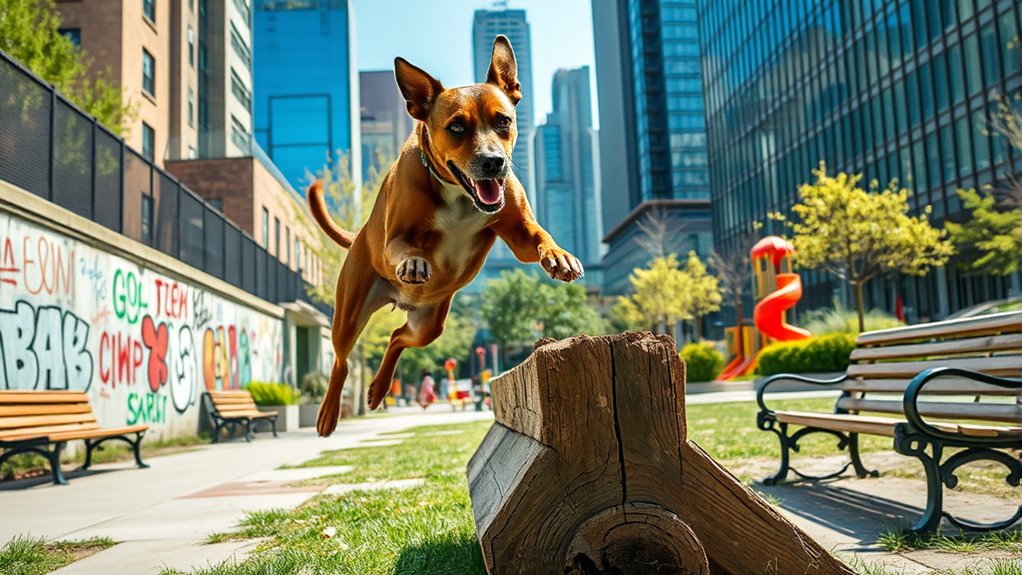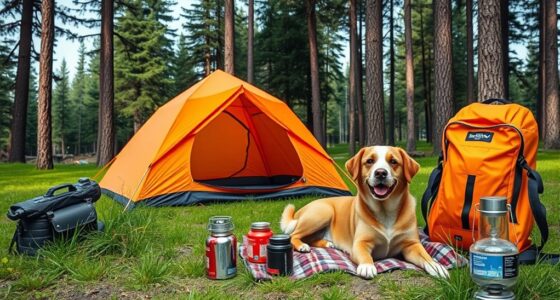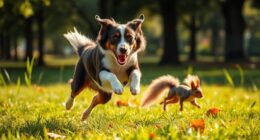Dog parkour is a fun way to boost your energetic dog’s agility and confidence by guiding them through urban obstacle courses. You can build strong communication through basic commands like sit, stay, and come, then introduce obstacle cues such as “over” or “through.” Always prioritize safety with proper equipment and environment, gradually increasing challenges. Keep training positive and engaging—if you’re interested, you’ll discover more tips to turn your city into an exciting agility playground.
Key Takeaways
- Dog parkour enhances urban agility by navigating obstacles safely in city environments, boosting confidence and physical fitness.
- Use positive reinforcement and basic commands to build a strong communication foundation before introducing complex obstacles.
- Ensure safety by inspecting obstacles, choosing enclosed areas, and using appropriate, non-slip equipment suited to your dog’s size.
- Gradually increase obstacle difficulty, celebrating small successes to boost your dog’s confidence and enjoyment.
- Keep training sessions short, frequent, and fun, providing water and breaks to prevent fatigue and ensure a positive experience.

Dog parkour is a fun and engaging activity that challenges your dog to navigate a variety of obstacles, improving both their agility and confidence. As you introduce your dog to parkour, it’s indispensable to focus on proper training techniques that build their skills gradually. Start with basic commands like sit, stay, and come to establish a solid foundation of communication. Then, incorporate obstacle-specific cues such as “up,” “over,” or “through” to guide them through each element. Use positive reinforcement consistently—praise, treats, or toys—to motivate your dog and reinforce successful attempts. Keep training sessions short and frequent to prevent fatigue and frustration, especially when introducing new obstacles. Remember, patience is key; never force your dog to attempt something they’re uncomfortable with. Instead, encourage and reward progress, guaranteeing they associate parkour with fun and achievement. Additionally, understanding remote work benefits such as flexibility and reduced stress can help owners balance their training schedules more effectively.
Safety precautions are equally indispensable to keep your dog safe during parkour activities. Always inspect the obstacles and environment beforehand, ensuring there are no sharp edges, loose parts, or hazards that could cause injury. Choose a safe, enclosed area where your dog can move freely without the risk of escaping or encountering dangerous objects. Use appropriate equipment tailored to your dog’s size and skill level—avoid makeshift or unstable structures. When practicing jumps or climbs, guarantee the surfaces are non-slip to prevent slips and falls. Warm up your dog with gentle exercises beforehand to loosen their muscles and reduce the chance of strains or sprains. Keep a close watch for signs of fatigue or discomfort, and be ready to pause or end the session if needed. Hydration is indispensable; provide fresh water and take breaks as necessary.
Building your dog’s confidence through gradual exposure and positive experiences is essential. Never rush progress or push your dog beyond their comfort zone. Instead, celebrate small wins, and always prioritize safety and well-being. By combining correct training techniques with vigilant safety precautions, you help your dog develop agility skills while minimizing the risk of injury. This approach not only makes parkour sessions enjoyable for your furry friend but also strengthens your bond through shared activities. As your dog becomes more skilled, you can introduce more complex obstacles and increase the challenge, all while maintaining a safe and supportive environment. Remember, patience, consistency, and attentiveness are your best tools on this exciting journey into urban agility.
Frequently Asked Questions
What Equipment Is Best for Beginner Dog Parkour Training?
For beginner dog parkour training, start with simple equipment like ramps, low hurdles, and tunnels. Use basic training techniques such as positive reinforcement to encourage confidence. Always prioritize safety gear like harnesses and non-slip mats to prevent injuries. Keep sessions short and fun, gradually increasing difficulty as your dog gains skill. This approach helps build your dog’s agility while ensuring a safe, enjoyable experience for both of you.
How Do I Prevent My Dog From Getting Injured During Parkour?
To prevent your dog from getting injured during parkour, focus on dog parkour safety and injury prevention techniques. Always start with basic skills and gradually increase difficulty. Use non-slip surfaces and make sure equipment is secure. Keep training sessions short and positive, watch for signs of fatigue or discomfort, and never push your dog beyond their limits. Regular vet check-ups also help identify potential issues early and keep your dog healthy.
Can Senior Dogs Safely Participate in Parkour Activities?
You can’t teach an old dog new tricks, but senior dogs can still enjoy parkour safely if you prioritize senior dog safety and consider their age-related agility. Start slow, adapt activities to their comfort level, and avoid high-impact jumps. Always consult your vet beforehand, and watch for signs of fatigue or discomfort. With proper modifications, your older dog can stay active and happy while minimizing injury risks.
How Often Should I Train My Dog in Parkour?
You should train your dog in parkour 2 to 3 times a week to maintain progress without overdoing it. Consistency tips include keeping sessions short and fun, gradually increasing difficulty, and observing your dog’s responses. Pay attention to signs of fatigue or discomfort, and always prioritize your dog’s safety. Regular training helps build confidence and agility, making parkour a rewarding activity for both of you.
Are There Specific Breeds That Excel in Dog Parkour?
Certain breeds excel in dog parkour due to breed suitability and agility differences. You’ll find that Border Collies, Australian Shepherds, and Jack Russell Terriers often perform well thanks to their natural agility and energy. However, every dog is unique, so consider your dog’s individual abilities and temperament. With proper training, many breeds can develop impressive parkour skills, regardless of their breed suitability or agility differences.
Conclusion
Getting your energetic dog into parkour isn’t just fun—it boosts their confidence and keeps them healthy. Did you know that dogs who engage in regular agility exercises are 30% less likely to develop obesity-related issues? So, next time you hit the city streets or a nearby park, try incorporating some urban agility. It’s a great way to strengthen your bond and give your pup the mental and physical workout they crave.










